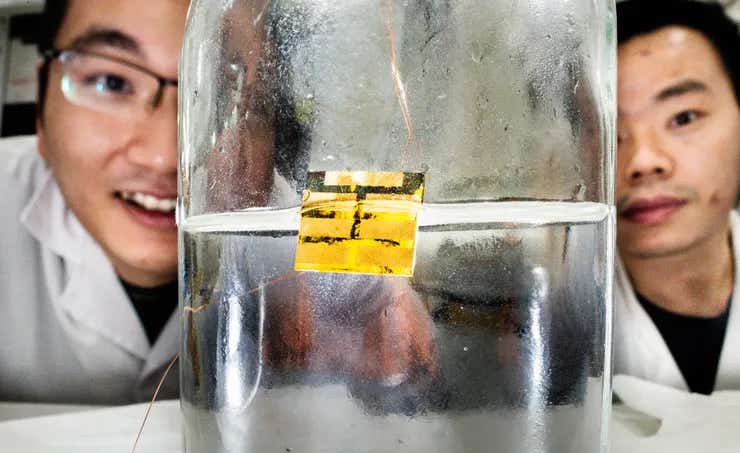Next-generation solar cell is fully recyclable
Scientists develop a sustainable method to recycle perovskite solar cells using water instead of hazardous solvents, preserving efficiency and reducing waste.

Researchers at Linköping University have developed a method to recycle all parts of a perovskite solar cell repeatedly using water as the main solvent. (CREDIT: Thor Balkhed)
The increasing demand for electricity, driven by artificial intelligence, electrified transportation, and industrial expansion, has intensified the need for sustainable energy solutions.
Solar power, a renewable and abundant energy source, has been widely adopted through silicon-based photovoltaic panels. However, as these panels reach the end of their lifespan, the industry faces a growing challenge: managing solar waste.
The Mounting Problem of Solar Waste
Silicon solar panels, in use for over three decades, have significantly contributed to the global renewable energy transition. Yet, their disposal presents a pressing issue. With no efficient recycling process in place, many end up in landfills, creating vast amounts of electronic waste.
“There is currently no efficient technology to deal with the waste of silicon panels. That’s why old solar panels end up in the landfill. Huge mountains of electronic waste that you can’t do anything with,” says Xun Xiao, a postdoctoral researcher at Linköping University.
This challenge has pushed policymakers worldwide to enforce extended producer responsibility regulations. In the European Union, the Waste Electrical and Electronic Equipment (WEEE) directive mandates manufacturers to collect and recycle end-of-life photovoltaic products. Similar legislation exists in the United States and Asia, requiring producers to manage solar panel disposal sustainably.
As the industry shifts toward newer solar technologies, addressing these concerns early can prevent history from repeating itself. One of the most promising solutions comes from the next generation of solar cells: perovskite photovoltaics.
The Rise of Perovskite Solar Cells
Perovskite solar cells offer an attractive alternative to traditional silicon panels. They are lightweight, flexible, and can be applied to various surfaces, including windows and curved structures. Additionally, they exhibit high power conversion efficiency, with some reaching up to 25%—comparable to modern silicon cells.
Related Stories
“There are many companies that want to get perovskite solar cells on the market right now, but we’d like to avoid another landfill. In this project, we’ve developed a method where all parts can be reused in a new perovskite solar cell without compromising performance in the new one,” says Niansheng Xu, another postdoctoral researcher at Linköping University.
Despite their advantages, perovskite solar cells have a shorter lifespan compared to their silicon counterparts. They also contain a small amount of lead, which is crucial for efficiency but poses environmental concerns. Proper recycling methods are essential to minimize waste and prevent harmful substances from leaching into the environment.
The Challenge of Recycling Perovskite Cells
Recycling perovskite solar cells is not a new concept. Conventional methods involve dissolving layers using hazardous solvents such as dimethylformamide (DMF), which is commonly found in paint removers. While effective in extracting materials for reuse, these solvents are toxic, environmentally damaging, and pose health risks.
Feng Gao, professor of optoelectronics at Linköping University, emphasizes the importance of integrating sustainability into solar technology development.
“We need to take recycling into consideration when developing emerging solar cell technologies. If we don’t know how to recycle them, maybe we shouldn’t put them on the market at all.”
Recognizing this issue, researchers at Linköping University have developed a breakthrough solution: a recycling process that eliminates the need for hazardous solvents. Instead, their method uses water as the primary solvent, making it a safer and more environmentally friendly alternative.
A Breakthrough in Solar Recycling
The innovative process, published in Nature, enables the complete recovery of all solar cell components—covering glass, electrodes, perovskite layers, and charge transport layers—without compromising efficiency. The recycled solar cells maintain the same performance as newly manufactured ones.
“We can recycle everything—covering glasses, electrodes, perovskite layers, and also the charge transport layer,” says Xun Xiao.
This discovery represents a major step forward in solar sustainability. By using water as a solvent, the process reduces environmental risks and aligns with industrial safety standards. More importantly, it offers a scalable recycling approach that could be integrated into large-scale production.
Looking ahead, the researchers aim to refine their method for industrial application. If successful, this innovation could redefine the solar industry’s approach to waste management, making perovskite solar cells not only efficient but also truly sustainable.
As the world transitions toward renewable energy, integrating recycling technologies into solar production is essential. With growing electricity demands and environmental concerns, breakthroughs like this could shape the future of solar power—ensuring clean energy without creating new waste problems.
Note: Materials provided above by The Brighter Side of News. Content may be edited for style and length.
Like these kind of feel good stories? Get The Brighter Side of News' newsletter.
Rebecca Shavit
Science & Technology Journalist | Innovation Storyteller
Based in Los Angeles, Rebecca Shavit is a dedicated science and technology journalist who writes for The Brighter Side of News, an online publication committed to highlighting positive and transformative stories from around the world. With a passion for uncovering groundbreaking discoveries and innovations, she brings to light the scientific advancements shaping a better future. Her reporting spans a wide range of topics, from cutting-edge medical breakthroughs and artificial intelligence to green technology and space exploration. With a keen ability to translate complex concepts into engaging and accessible stories, she makes science and innovation relatable to a broad audience.



